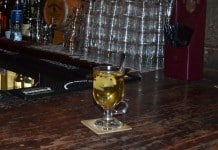
The History of Irish Whiskey is a long and intriguing one. From its humble beginnings several hundred years ago to the thriving industry that it is today, whiskey has held a fond place in many hearts over the centuries.
History of Irish Whiskey Distillation
The actual process of distillation pre-dates the development of whiskey as a beverage by several hundred years.
This procedure, wherein liquids are heated to separate elements via condensation and evaporation, was first discovered by Greek alchemists in the 1st century.
It is widely believed that travelling missionary monks brought this technique back to Ireland some time around the 8th century, where it was used to distil perfume.
Further experimentation resulted in the creation of drinkable spirits, known as uisce beatha.
A translation of the Latin phrase aqua vitae, this literally meant water of life. The modern term whiskey may well be simply a mispronunciation of this term.
The process of distilling alcohol was refined over several centuries, with written references made to the spirit usquebaugh, as far back as the beginning of the 15th century.
Licensing History of Irish Whiskey
By the time of the reign of Queen Elizabeth the First, Irish whiskey was firmly gaining a foothold as one of the most popular spirits in this part of the world.
The Queen was said to be such a fan that in 1541 she requested substantial stocks of it to be delivered to her court, deeming it to be far superior to the English aqua vitae. At this time production was very much a cottage industry, with many people simply setting up a basic distillery in their home.
This continued for another one hundred and fifty years until the introduction of legislation governing the making of this previously largely home-brewed drink.
The oldest surviving licensed distillery in the country is said to be that belonging to Bushmills, with the company claiming to have a license issued as far back as 1608 by King James the First. The Bushmills Distillery Company was established in 1784 and is still producing spirits today.
Development of a Global Enterprise
The introduction of licensing heralded the start of production as a legitimate global enterprise and whiskey had soon garnered a reputation as the spirit of choice for both royalty and the public.
This was partially due to the whiskey industry in Ireland being significantly more advanced in terms of reach than its Scottish counterpart, together with a widely-held belief that the product was superior. However, the imposition of a tax on spirits by the British government in 1661 had something of a detrimental effect.
Production slowed in licensed distilleries but was off-set by a substantial increase in the number of unlicensed distilleries. It is estimated that by the 1770s there were approximately 1200 distilleries in Ireland, the vast majority of which were unlicensed.
Creative Work-Arounds
These financial penalties forced the distilleries to look for creative ways in which to continue operating without falling foul of the law.
Since one of the more exorbitant taxes was on malted barley, Irish distillers began to create a blend supplementing this with other ingredients, including unmalted barley.
The result was a spirit that came to be known as Pot Still whiskey, renowned as a distinctly individual Irish product. As legislation was later relaxed, mass production flourished and by the mid-1880s, whiskey was once again the world’s favourite spirit.
Scotch Enters the Whiskey Market
Scotland was by this time producing its own version, which was also well-received. Utilising a different type of still and distillation processes, the result was a lighter-tasting beverage, which some found appealing.
However, this blended spirit was not regarded by Irish distillers as possessing the necessary qualities to be described as whiskey.
Interestingly it is believed that Irish distilleries added the extra E into the traditional spelling of whisky some time during the 19th century in order to distinguish their product from that made in Scotland.
The two products have maintained a friendly rivalry ever since.
American Consumption of Irish Whiskey
In the early 20th century, America was one of the largest consumers of Irish whiskey. However, the Prohibition movement during the 1920s and 1930s had a significant impact on the export business with the result that many distilleries went out of business.
Fortunately in the late 1980s the industry enjoyed something of a resurgence. High profile marketing campaigns combined with public interest in consumption of this highly-regarded spirit gave rise to a new demand for top quality produce.
The industry is now thriving, with production levels rising annually in order to keep pace with soaring demand.
Current Production
Today there are many different types of whiskey available. The way in which they are categorised is dependent both upon the ingredients used and the method of production.
Single malt whiskey is made at one distillery using a mash made entirely from malted barley, and in many cases is double or triple distilled.
Blended malt whiskey is not as common in Ireland as in other whiskey-producing countries, but refers to a drink made by blending single malts from a number of different distilleries.
Single grain whiskey is made in one distillery but may be comprised of grains other than solely malted barley, such as wheat.
In contrast to spirits from other countries, whiskey in Ireland must be aged for a minimum of three years in wooden casks to qualify for the distinguished title.
The Most Famous Single Pot Whiskey
One of the most distinctive blends in the History of Irish Whiskey is Single Pot Still whiskey. This is a uniquely Irish preparation, and refers to the way in which the wash is heated. Unlike the continuous distillation process, heat is applied directly to the pot or still in which the wash is held.
Despite the use of the word single, this whiskey is made from a blend of malted and unmalted barley, usually in a ratio of approximately 40:60.
Using this mixture gives the whiskey its distinctive Pot Still character, with a delicious touch of spiciness and consistent taste.
Appreciation for the Irish Water of Life
Developed and refined over the last few hundred years, the fascinating history of Irish whiskey and has evolved into one of the most popular drinks in the world.
Not only has it found favour as an ingredient in the contemporary cocktail industry but it has reached new markets with the development of the Irish coffee.
Additionally there is a renewed appreciation for the complex flavour and refined production methods of this most distinctive drink.
With the opening of more distilleries and ever-larger markets, this type of whiskey has been the fastest-growing spirit in the world every year since 1990, with its popularity expected to remain unabated in the next few decades.
Jameson Irish Whiskey continues to be the world’s most popular Irish whiskey with sales of 6.5 million nine-litre cases in the last 12 months.




